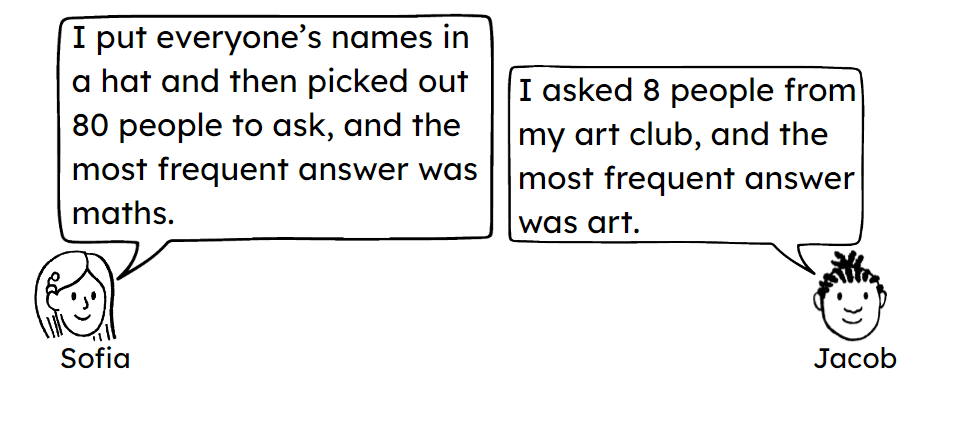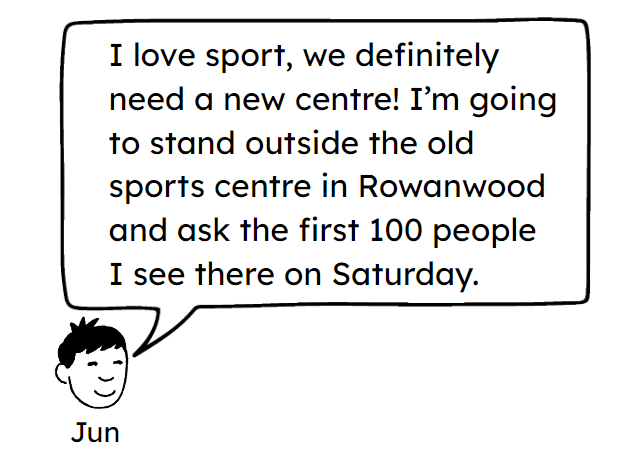Myths about teaching can hold you back


- Year 10•
- Foundation
Sampling limitations
I can state the limitations of a sample and the impact of different sample sizes.


- Year 10•
- Foundation
Sampling limitations
I can state the limitations of a sample and the impact of different sample sizes.
These resources will be removed by end of Summer Term 2025.
Switch to our new teaching resources now - designed by teachers and leading subject experts, and tested in classrooms.
These resources were created for remote use during the pandemic and are not designed for classroom teaching.
Lesson details
Key learning points
- A sample can only produce conclusions for that sample.
- A different sample may produce different conclusions.
- The usefulness of any conclusions may be limited by the sample size.
Keywords
Sample - A sample is a subset of the population.
Bias - Bias can be present in any sample collected from a population and may affect the results of a statistical investigation.
Common misconception
Samples always represent the population from which they are drawn as they come from that population.
Taking multiple large samples allows us to begin to generalise the results to the whole population.
To help you plan your year 10 maths lesson on: Sampling limitations, download all teaching resources for free and adapt to suit your pupils' needs...
To help you plan your year 10 maths lesson on: Sampling limitations, download all teaching resources for free and adapt to suit your pupils' needs.
The starter quiz will activate and check your pupils' prior knowledge, with versions available both with and without answers in PDF format.
We use learning cycles to break down learning into key concepts or ideas linked to the learning outcome. Each learning cycle features explanations with checks for understanding and practice tasks with feedback. All of this is found in our slide decks, ready for you to download and edit. The practice tasks are also available as printable worksheets and some lessons have additional materials with extra material you might need for teaching the lesson.
The assessment exit quiz will test your pupils' understanding of the key learning points.
Our video is a tool for planning, showing how other teachers might teach the lesson, offering helpful tips, modelled explanations and inspiration for your own delivery in the classroom. Plus, you can set it as homework or revision for pupils and keep their learning on track by sharing an online pupil version of this lesson.
Explore more key stage 4 maths lessons from the Sampling unit, dive into the full secondary maths curriculum, or learn more about lesson planning.

Licence
Prior knowledge starter quiz
6 Questions
Q1.Capture-recapture is a sampling method which allows you to the size of a population without counting it fully.
Q2.Jacob captures 10 birds and marks each one with some non-toxic dye. Jacob recaptures 10 birds, but finds that none of them have a paper band. Select the possible reasons for this.
Q3.Which of these assumptions are made when the method of capture-recapture is used?
Q4.As part of a capture-recapture sample, 200 fish from a lake are captured and marked with a white dye. During a recapture of 100 fish, 12 were marked with the white dye. Select the correct statement.
Q5.Laura captures 9 deer and marks them by attaching a tag to their legs. Three days later, Laura recaptures 40 deer, and 4 of them have a tag attached. Estimate the total number of deer.
Q6.Jun captures 21 squirrels and marks them by attaching a tag to their legs. Three days later, Jun recaptures 46 squirrels, and 7 of them have a tag attached. Estimate the total number of squirrels.
Assessment exit quiz
6 Questions
Q1.__________ can be present in any sample collected from a population and may affect the results of a statistical investigation.
Q2.Laura flips a coin three times and it lands heads each time. Laura concludes the coin is biased. Is Laura correct?
Q3.Izzy wants to find out what type of music is most popular among pupils at her school. She asks 5 of her friends who their favourite singer is. Which of these comments are correct?
Q4.Jacob and Sofia have both investigated what the favourite subject of the year 10 pupils in their school is. sample is more likely to be representative of the population.

Q5.Jacob and Sofia have both investigated what the favourite subject of year 10 pupils in their school is. Select the statements that are likely to be true.

Q6.Jun wants to find out if the town of Rowanwood needs a new sports centre. Comment on Jun's sampling method.


